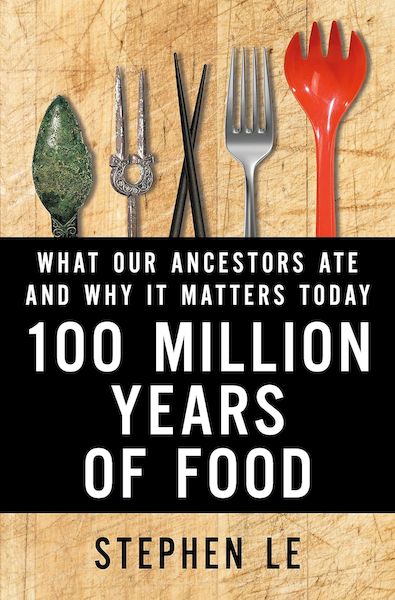Have you ever pondered why diet-related ailments afflict the Western world? More individuals today struggle with obesity, food allergies, various types of cancer, and type 2 diabetes than ever before.
It appears something is not quite right with our eating patterns. However, identifying what is amiss with how we’re consuming presently and determining what we should be practicing instead is challenging. The encouraging news is we might discover a few solutions to this query from our ancestors’ dietary habits. In recent years, there has been a significant increase in paleo or primal diets.
Considering our forebears were generally much fitter than modern humans, we are striving to replicate that. This book explores whether the dietary selections of these ancient predecessors would be suitable for us in the present day. We need to go way back in time – commencing 100 million years ago with our earliest, tree-dwelling ancestors. By examining how these ancestors adjusted to varying environments and diets, we gain a comprehensive perspective.
On this captivating exploration through the evolution of humanity, you’ll discover
- Bugs – why we should eat some every now and then.
- Milk – does it genuinely benefit the body?
- Plants – are they sustenance or toxicity?

1: Insects and fruits
Imagine if one of our earliest ancestors strolled into one of today’s supermarkets? They would be overwhelmed by the choices. The distinction between the dining options accessible to our ancient ancestors and the crammed, vividly colored aisles of contemporary grocery stores could scarcely be more pronounced.
Our earliest ancestors emerged around 100 million years ago and inhabited the trees of tropical forests. They mainly feasted on the insects abundant in this habitat. Disgusting, isn’t it? Insects are genuinely a nutrient-rich source of vitamins and iron.
Despite insects still possibly being a valuable addition to the modern human diet, relying solely on bugs wouldn’t be wise. Chitin, which forms the exoskeletons of insects, is indigestible to us now, whereas our ancestors possessed enzymes that enabled them to break down this substance. Bugs can also incite allergies and produce noxious substances.
Nevertheless, integrating insects into the human diet in modest quantities could be tremendously advantageous to contemporary food production. Insects can be farmed akin to livestock and are considerably more efficient. Crickets convert feed into calories 12 times more effectively than cows per pound and emit approximately 50 percent less carbon dioxide in the process.
Despite their merits, our ancestors commenced modifying their dietary practices around 60 million years ago. The climate began cooling at this time, and the first fruit-bearing trees emerged as the atmosphere turned more humid. Simultaneously, our ancestors lost the capability to synthesize vitamin C, a crucial nutrient that safeguards against cell damage, during this era.
Since they could obtain ample vitamin C from fruit, they survived this transition. Our ancestors transitioned to full-time fruit consumption around 30 million years ago. However, overindulging in fruit can also be detrimental. Fruit contains fructose, a form of sugar that our bodies can only metabolize in restricted amounts; excessive sugar intake can lead to conditions like insulin resistance and pancreatic cancer.
Actor Ashton Kutcher experienced the perils of excessive fructose firsthand. Kutcher adhered to Steve Job’s fruitarian diet for a month while preparing to portray the tech CEO. After just 30 days of following this regimen, Kutcher was hospitalized with pancreatic complications.
2: Meat
About two million years ago, our ancestors’ diet underwent another transformation. They began departing from the trees and embracing a more terrestrial way of life. These early humans commenced hunting, foraging, and consuming more meat than ever before.
They began resembling humans more closely, and their brains underwent swift growth. The fatty acids in meat make it the ideal fuel for a developing brain. In fact, the brain size of our ancestors doubled within just one million years, a change that might have been attributable to their increasingly carnivorous diets.
With these enlarged brains, our ancestors attained an evolutionary edge. Smarter, more coordinated hunting groups could take down more prey, enhancing their families’ likelihood of survival and propagation. Despite meat potentially being the catalyst for our evolutionary triumph, excessive consumption of it is not conducive to our well-being.
We can tolerate protein only to a limited extent, and meat is replete with it. Proteins can trigger the production of potentially hazardous nitrogen compounds when digested by the human body. If an individual derives over 40 percent of their daily caloric intake from protein, the levels of these compounds can escalate perilously.
Additional cholesterol is another reason why an overabundance of meat consumption can be detrimental to our health. It can conjoin with other substances and obstruct our arteries. Nonetheless, do not assume cholesterol is entirely harmful.
Vital sex hormones like testosterone and estrogen are synthesized from cholesterol. Additionally, cholesterol can enhance our moods by elevating the levels of high-density lipoprotein or HDL. Although most of the body’s cholesterol is manufactured by our liver and intestines, meat and dairy supply supplementary sources that influence our hormone levels.
Females on a diet rich in cholesterol may attain sexual maturity sooner. While this enhances their potential reproductive output by facilitating earlier childbirth, it also shortens their lifespan.
3: Meat alternatives
Were you aware that substitutes for red meat are far from novel? Presently, we have an array of dietary options available, making it more convenient to adhere to a balanced vegetarian diet than in the past. Even our ancestors with a penchant for meat diversified. Although not every individual developed a taste for fish, it prevailed over red meat in numerous cultures. Ever questioned how this materialized? Red meat was scarce in several regions, prompting the inclusion of fish, a readily available and nutritious sustenance. Since fatty fish are replete with beneficial omega‑3 fatty acids and vitamin D, essential for skeletal health, this was a prudent decision.
Despite easy access to fish, not every culture opted to incorporate it into their diets. Various cultural rationales underpinned this choice. While some cultures revered fish as sacred creatures dwelling in a divine milieu, others, like the Apache Indians, deemed fish unhygienic and unsuitable for consumption.
Animal milk was another significant alternative to meat that infiltrated the human diet roughly 8,000 years ago. However, animal milk is not as salubrious for human ingestion as commonly believed, notwithstanding it often being perceived as a panacea of sorts. Northern Europeans were among the first to recognize the merits of animal milk.
It is nutrient-rich and abundant in calcium. Crucially, an animal can be consumed only once, but it can be milked repeatedly. While statistics establish a correlation between milk consumption and children’s height growth, this surge in stature may come at a cost.of skeletal system strength. A connection can be observed in the countries with the highest dairy intake. The inhabitants of these nations with above-average stature also face increased rates of hip fractures.
Consumption of milk may pose an additional problem for individuals from regions with limited history of dairy consumption. These individuals absorb calcium more effectively than those from areas where milk is traditionally ingested. This implies that these individuals might encounter dangerously heightened calcium levels if they consume a large amount of milk. Elevated blood-calcium levels have been associated with prostate cancer. Next, we will delve into the background of vegetables and their role in the nutritional hierarchy.
4: Consuming Plants
At some point, your parents probably emphasized the importance of consuming your vegetables. We all acknowledge that vegetables are nutritious and brimming with essential nutrients, don’t we? The reality is, most plants are actually not conducive to health, and some are even hazardous. Why is this so? Consider this; plants lack the ability to flee and are surrounded by other organisms that aim to consume them.
They are compelled to defend themselves as they cannot escape. They accomplish this by producing substances that deter, harm, and sometimes eradicate the animals attempting to consume them, essentially engaging in chemical warfare.
Wild vegetables may contain bitter compounds or toxins to discourage consumption, and it’s only in the domesticated variants that these traits have been eliminated. Legumes, pulses, and soybeans serve as a good example. They contain compounds known as lectins, which may lead to illness and potentially result in liver harm. A variation of lectin referred to as ricin is among the most lethal toxins recognized by humankind.
It’s present in the seeds of the castor oil plant and can lead to excruciating death even in minuscule quantities. This makes one ponder why humans initially started consuming plants, doesn’t it? The shift towards agriculture by humans occurred approximately 12,000 years ago in various regions of the world concurrently. The hypothesis is that other food alternatives became scarce, prompting us to resort to cultivating and consuming plants.
The primary notion as to why this transition took place was due to overhunting by humans and the expansion of trees into the grasslands they inhabited, triggered by the extinction of large prey animals such as the mammoth.
Humans commenced seeking out alternative options when this major food source was lost. Plants were easily accessible and could be cultivated with relative ease, making them appear to be the ideal choice. Plant-derived foods predominated in densely populated regions and areas where maintaining animals proved to be challenging.
5: Swift Transformations
The human body’s adaptability is quite remarkable. We possess a unique ability to acclimate to significant dietary modifications. Nevertheless, this process requires time, potentially spanning generations. With the ascendancy of food processing, the sluggishness of the adaptation process posed a genuine challenge. With insufficient time to adjust to this shift, humans began encountering a myriad of new ailments.
For instance, a distressing ailment known as beriberi emerged in the latter half of the nineteenth century among wealthier individuals in East and Southeast Asia. Heart complications, mobility issues, and mental perplexity afflicted individuals afflicted with this condition.
It was subsequently revealed that a severe deficiency of B1 triggered the illness. It was the affluent individuals who bore the brunt since they could afford to procure the “refined” highly polished rice. The refining process had stripped away most of its B1 content. Another disorder stemming from nutrient deficiency, Pellagra, became widespread among the less affluent populations of the American South around 1900.
This ailment, characterized by severe symptoms such as red sores, debilitation, and even dementia, resulted from alarmingly low levels of vitamin B3. These communities had been subsisting solely on items crafted from industrially milled corn, which, in contrast to fresh corn, lacked a sufficient amount of this essential nutrient.
While processed food poses a threat to human well-being, it is not the sole concern. Other lifestyle modifications can also have adverse effects on our health. The prevalence of asthma and food allergies is on the rise. Although there exists a debate regarding specifics, it is probable that lifestyle choices are responsible. Presently, individuals spend a far greater amount of time indoors compared to previous eras.
This translates to diminished levels of vitamin D, also dubbed the “sunshine vitamin,” owing to reduced exposure to sunlight, which triggers our body to synthesize this nutrient. Given that expectant mothers with diminished vitamin D levels are more prone to delivering allergic offspring, this dynamic contributes to the escalating incidence of allergies among the general populace.
Another hypothesis elucidating the surge in allergies is known as the hygiene hypothesis. It posits that modern children, owing to being raised in excessively sanitized environments, develop allergies and asthma. The crux of this concept is that for a child’s immune system to learn how to differentiate between benign proteins and harmful bacteria and combat infections without going into overdrive, exposure to some germs is essential.
6: Some Extra Pounds
Studies reveal that on average, Japanese individuals consume 300 fewer calories per person than Americans. While this might sound healthy, is it prudent to emulate their approach? Although it is true that the Japanese exhibit a longer lifespan than Americans, this alone does not signify that their lifestyle is superior.
There are both advantages and drawbacks to limiting your calorie intake. Ingesting too few calories can lead to decreased concentration by depriving your brain of requisite sustenance. Prolonged insufficiency of protein can result in muscle weakness.
It’s all about striking a balance. Many animals will scale back non-essential bodily functions, such as reproduction, when faced with a period of food scarcity. Humans are no exception. Women who consume fewer calories may live longer but might experience reduced fertility and heightened irritability.
Surprisingly, being slightly overweight is actually healthier. In fact, even if you are overweight, meticulously monitoring every calorie is not advisable. Thus, having a few extra pounds can be advantageous. Individuals with a body mass index between 25 and 30 generally exhibit a longer lifespan than those with normal weights.
It is plausible that individuals carrying excess weight possess heightened energy reserves to weather off weight loss during severe illnesses and harbor more fat to safeguard them from toxins, promoting improved health. Regardless of the health advantages associated with a few surplus pounds, reducing calorie intake may not aid in weight reduction.
The association between weight and caloric consumption is rather tenuous. Research indicates that slender, contemporary hunter-gatherers ingest approximately the same quantity of calories as your average modern-day American while engaging in similar levels of physical activity. The primary disparity is that they experience greater fluctuations in calorie intake across different seasons.
This implies that not all variations in body weight can be simplistically attributed to calorie intake and exercise. Finally, monitoring your total calories without regard for the quality of the food they originate from is futile. Irrespective of how few calories you ingest, if your diet predominantly comprises junk food and sugary beverages, your health will be compromised.
7: Consumption
You aim to eat in a health-conscious manner, but your friend invites you out for a buffet lunch. Are youDeciding between a bowl of oats, some meatballs, or a glass of Prosecco? Well, that really depends on your personal preferences. There’s no one-size-fits-all answer.
To identify the best dietary choices for you, take into account factors such as your age, cultural background, and your consumption habits. Most food and drinks aren’t inherently good or bad. Take alcohol, for example. Excessive intake can harm your brain and digestive system. Yet, studies suggest that moderate alcohol consumption can help combat heart disease in individuals above forty.
Your ethnic background also plays a role. Many people of Asian descent have a genetic predisposition that results in lower levels of alcohol dehydrogenase, the enzyme crucial for alcohol breakdown. As a result, they need to be mindful of their alcohol consumption. Asians tend to get more intoxicated per drink compared to their Caucasian counterparts due to alcohol entering their bloodstream at a faster rate.
Likewise, while young girls who consume a lot of meat may reach puberty earlier and face an elevated risk of certain cancers, elderly women — for whom early puberty is not a concern — might benefit from the protein in meat, boosting their strength.
Individual dietary requirements vary significantly, but that doesn’t mean eating has to be a solitary experience. Our ancestors used to hunt together and share their meals, fostering communal bonds and ensuring equitable food distribution.
Recreating this communal aspect of eating can have numerous benefits. Supporting pay-what-you-can eateries and enjoying meals with friends can promote a sense of togetherness. By making mealtime a shared experience, we can bring back the care and community that food once represented.
Final Summary
The main takeaway from this book is that the human diet has undergone significant evolution over millions of years. By tracing this evolutionary journey, we can understand the factors shaping our present-day diets. While there’s no one-size-fits-all dietary regimen, there are simple guidelines that can enhance both health and happiness.
Practical Advice: Consider selling your vehicle to prioritize your health. Opting for a more active lifestyle is widely recognized as beneficial. However, we often stick to what’s convenient unless forced to make a change. Selling your car could compel you to choose modes of transportation that involve physical activity.
To see the potential benefits of this lifestyle change on health, think about the inhabitants of some mountainous islands where road construction was impractical. Without cars as an option, the residents walk or bike for transportation. Consequently, these islanders tend to live longer, healthier lives than their mainland counterparts.


